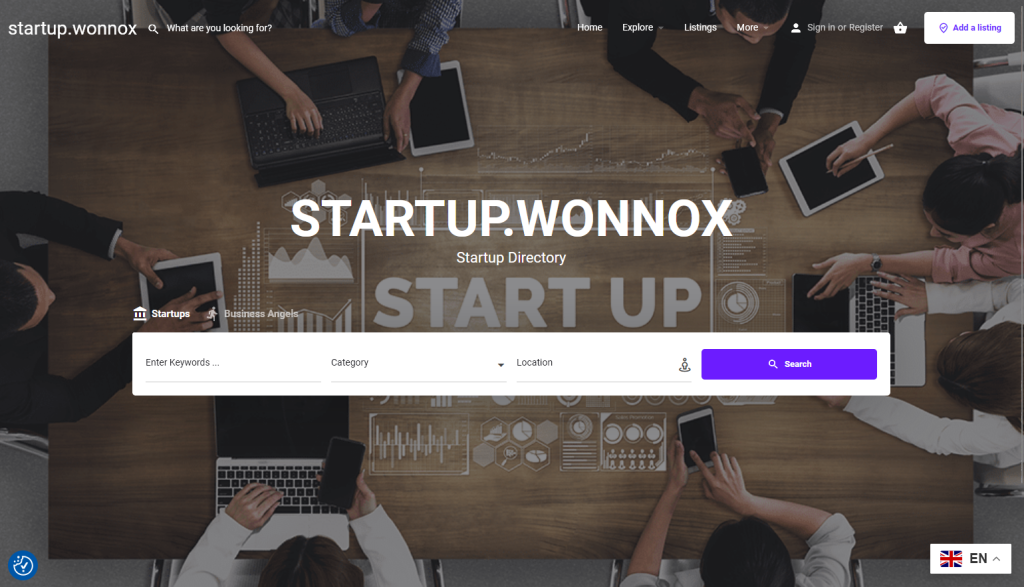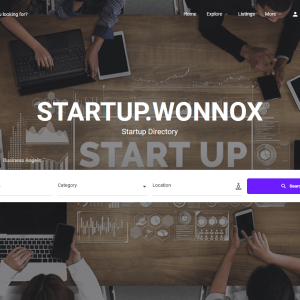
- Direct message
- Leave a review
- Bookmark
- Share
- Report
- prev
- next
Details
-
Wontox Portal
Description
A startup listing or profile in a web directory, especially within the "startup" category, serves as a crucial tool for new and emerging businesses looking to establish their presence, attract investors, customers, partners, and even potential employees. Startups often have unique selling points, innovative ideas, and dynamic teams, and a well-crafted profile in a web directory should highlight these elements to differentiate the startup from more established companies. Here’s a breakdown of the key features that make up an effective startup listing or profile, designed to provide a detailed overview and insights into the business:
1. Startup Overview:
Startup Name: The name of the startup is prominently displayed as the main identifier. It should be clear and memorable, providing a sense of the startup’s identity.
Tagline: A short, catchy phrase that captures the essence of the startup’s mission, vision, or primary value proposition. It should be easy to understand and evoke curiosity.
About Us: This section offers a brief description of the startup, its story, and its core purpose. It typically includes the origin of the startup, the problem it seeks to solve, and the journey so far. It’s a chance to tell the startup’s story, including why it was founded and the inspiration behind it.
2. Contact Information:
Physical Address: Including a physical address (or HQ location) helps add legitimacy to the startup and shows where it is based, even if the startup is operating mostly online or remotely.
Phone Number: Providing a direct phone number for customer inquiries, investor relations, or general inquiries enhances communication.
Email Address: A professional email address allows potential partners, customers, and investors to reach out directly.
Website URL: A clickable link to the startup’s website enables users to explore more about the company’s offerings, team, and culture.
Social Media Links: Links to social media platforms like LinkedIn, Twitter, Facebook, or Instagram provide potential clients and investors with a way to stay updated on the startup’s latest news, product updates, and milestones.
3. Business Description:
Industry and Sector: It’s important to identify the specific industry or sector the startup operates within (e.g., fintech, healthcare, e-commerce, AI). This helps categorize the startup, making it easier for users to find it when browsing the directory.
Problem Statement: Startups often gain traction by addressing a specific problem. Clearly stating the problem or market gap that the startup addresses helps potential clients, partners, and investors understand the startup’s relevance.
Unique Selling Proposition (USP): Highlighting what sets the startup apart from others in the same space is crucial. This could include an innovative business model, a proprietary technology, or a unique customer approach.
Target Market: Describing the customer segments or demographics the startup aims to serve (e.g., B2B, B2C, millennials, small businesses) provides clarity on who the startup is built for.
4. Products and Services:
Core Products or Services: This section outlines the main products or services the startup offers, providing potential clients with a clear understanding of what the startup delivers.
Product Features: Highlighting the key features of a product or service, especially if it includes innovative aspects like AI integration, user-friendly design, or sustainability, helps attract interest.
Product or Service Roadmap: A roadmap showing upcoming features or products gives users insight into future developments and shows that the startup has a strategic growth plan.
Customer Use Cases: Including real-world applications or examples of how customers use the startup’s offerings can help potential clients and investors visualize the product’s value.
5. Team and Founders:
Founders’ Bios: Introductions to the founding team with brief biographies that focus on their expertise, past experiences, and achievements. Investors often look for founders with a strong track record and relevant industry knowledge.
Key Team Members: Highlighting key team members such as the CTO, CMO, or Head of Product can help establish the startup’s competence in various areas like technology, marketing, or product development.
Team Culture: Including a description or images of the company culture can give a sense of the work environment and ethos of the startup, which is especially important for potential employees and partners.
6. Traction and Milestones:
Key Achievements: Highlighting important milestones such as reaching a certain number of users, securing funding, launching a new product, or achieving significant revenue can build credibility.
Press Mentions: Featuring notable mentions or articles from respected publications can add authority to the startup’s profile.
User Metrics: If applicable, metrics like the number of active users, downloads, or customer satisfaction rates can demonstrate market validation and growth potential.
Growth Rate: Including information about user growth, revenue growth, or market expansion can be particularly appealing to investors looking for high-growth potential.
7. Funding Information:
Funding Rounds: Information about the funding rounds the startup has completed (e.g., Seed, Series A, Series B) and the amounts raised can be included to give potential investors a sense of how the startup is financed.
Investors and Backers: Mentioning well-known investors, venture capital firms, or angel investors that have backed the startup adds credibility and signals market confidence.
Funding Goals: If the startup is actively looking for investment, mentioning current funding goals and areas of planned investment (e.g., scaling operations, marketing, product development) can attract interested investors.
8. Client Testimonials and Case Studies:
Testimonials: Including feedback from satisfied customers or early adopters helps build trust and provides social proof.
Case Studies: Detailed stories about how the startup has helped clients solve specific problems or achieve their goals can be compelling, particularly for potential B2B clients.
Client Logos: If the startup has worked with notable clients or partners, displaying their logos (with permission) can help boost credibility and attract similar clients.
9. Call to Action (CTA):
Engagement Prompts: A strong CTA encourages users to take action, whether it’s booking a demo, signing up for a newsletter, or scheduling a meeting with the startup’s team.
Examples of Effective CTAs: “Request a Demo,” “Join Our Beta Program,” or “Get in Touch for Partnership Opportunities” can prompt users to move forward with an interaction.
Subscription Links: If the startup offers a newsletter or updates, including a subscription link allows interested parties to stay informed about future developments.
10. Certifications, Awards, and Accreditations:
Awards and Recognitions: Mentioning awards won, such as "Startup of the Year" or industry-specific accolades, helps enhance the startup’s reputation.
Certifications: For certain industries, mentioning certifications (e.g., HIPAA compliance for healthcare startups) can reassure potential clients about the quality and reliability of services.
Industry Affiliations: Membership in industry organizations or participation in accelerator programs (e.g., Y Combinator, Techstars) can demonstrate the startup’s commitment to growth and learning.
11. Investor Relations Information:
Investment Deck or Pitch Video: If the startup is open to funding, providing a link to an investment deck or a pitch video can be useful for potential investors seeking more detailed information.
Current Valuation: Mentioning the startup’s current valuation can help position it within its market segment and indicate its potential growth trajectory.
Use of Funds: Being transparent about how previous funds were used and how future funds will be allocated (e.g., product development, market expansion) can provide investors with confidence in the startup’s strategic vision.
12. SEO and Keyword Optimization:
Keyword Integration: A well-optimized startup listing should include relevant keywords that potential clients or investors might use when searching for services or products in a particular industry.
Meta Descriptions: A concise meta description can help improve visibility in search engine results and attract more clicks.
Tags and Categories: Properly categorizing the listing within the web directory ensures that it reaches the right audience, whether they’re searching for “tech startups,” “green energy,” or “B2B solutions.”
13. Visual Elements:
Images and Logos: Including the startup’s logo, product screenshots, or images of the team can make the profile more engaging.
Video Introductions: A short introductory video that explains the startup’s mission, product, or value proposition can provide a more dynamic and engaging overview.
Infographics: Using infographics to illustrate market size, competitive advantages, or growth metrics can simplify complex information and make it more digestible.
14. Sustainability and Corporate Social Responsibility (CSR):
Environmental Initiatives: Highlighting any sustainable practices, such as eco-friendly products or operations, can attract environmentally conscious clients.
Community Involvement: Describing how the startup gives back to the community or supports social causes can enhance its appeal to values-driven consumers and partners.
These features collectively create a comprehensive and appealing startup listing that can serve as a powerful marketing tool. A well-designed startup profile in a web directory not only showcases the innovative products or services offered but also communicates the startup’s vision, values, and growth potential to attract clients, investors, and partners. By carefully combining detailed descriptions, compelling visuals, and strategic calls to action, startups can maximize their chances of standing out in competitive directories and reaching their desired audience.

Add a review